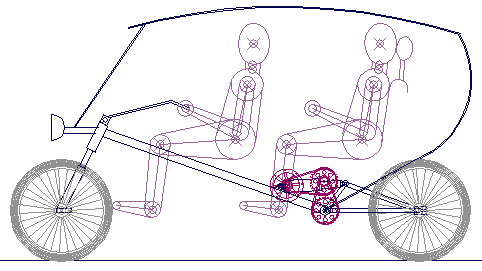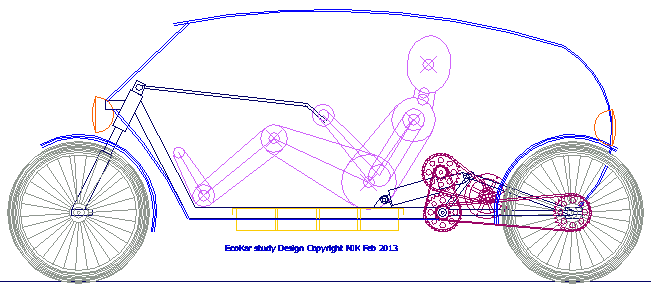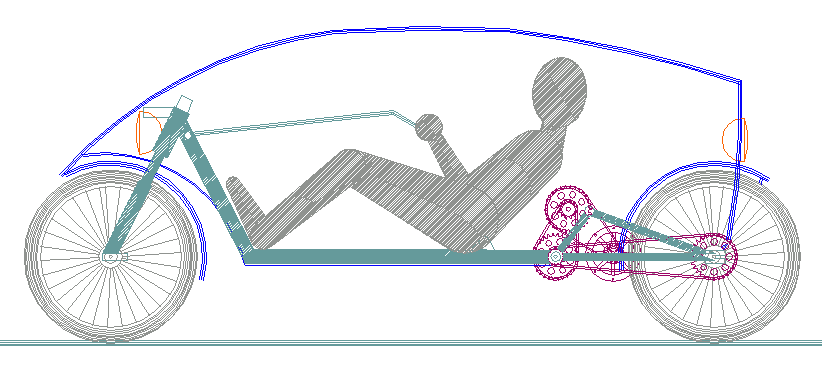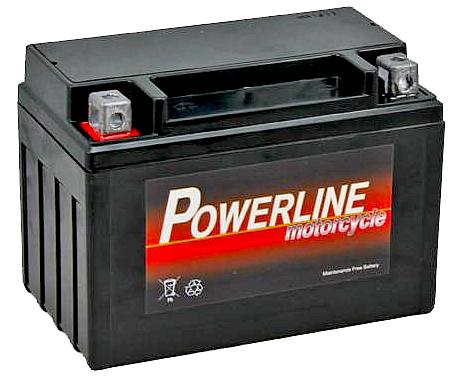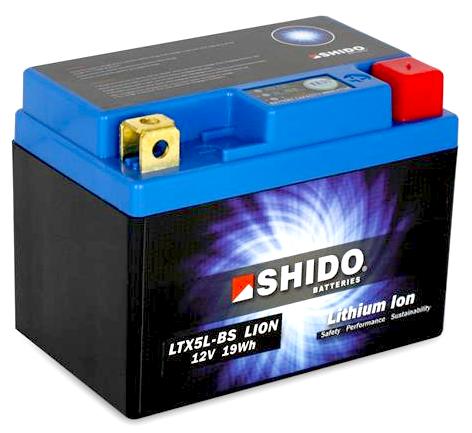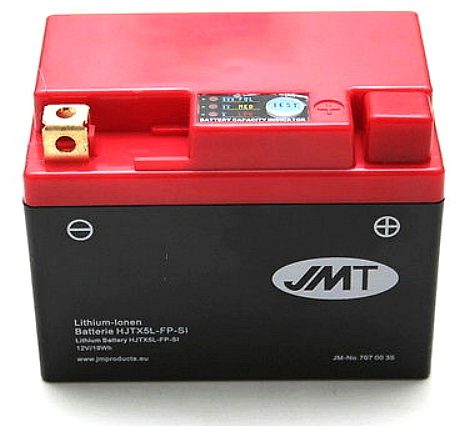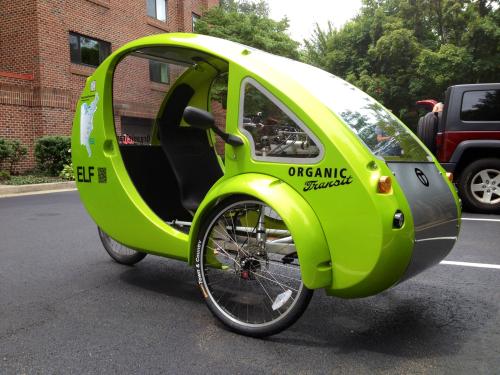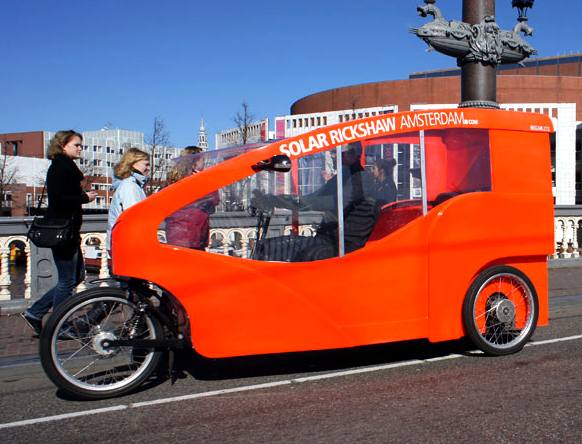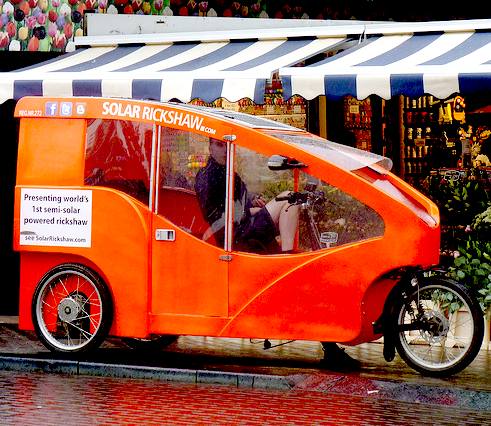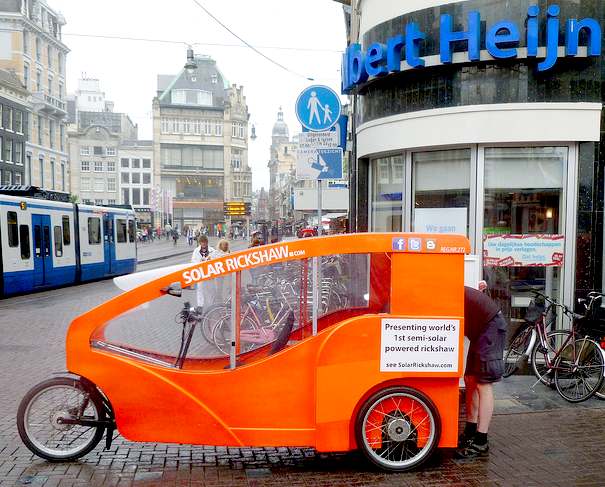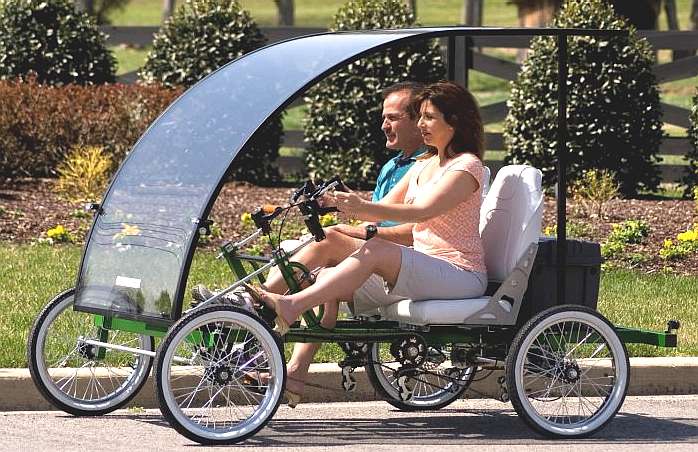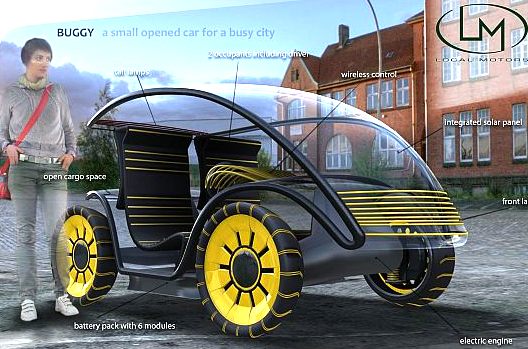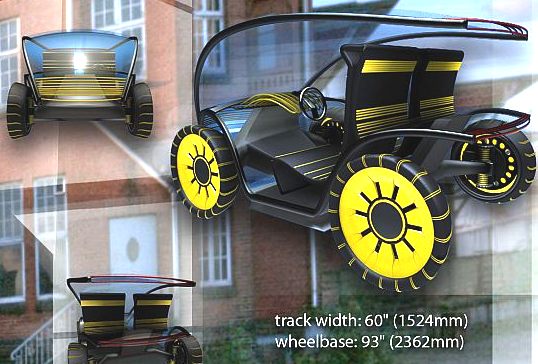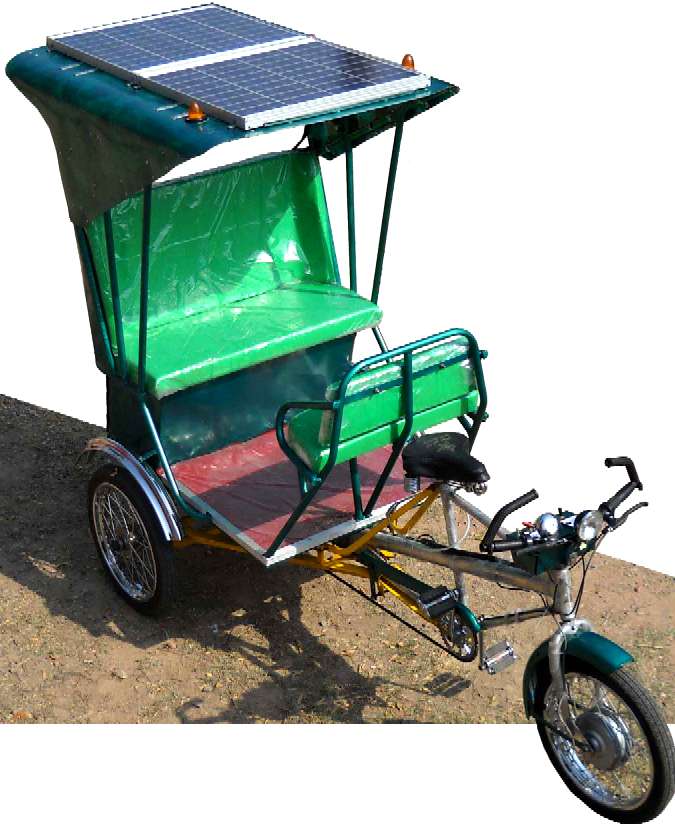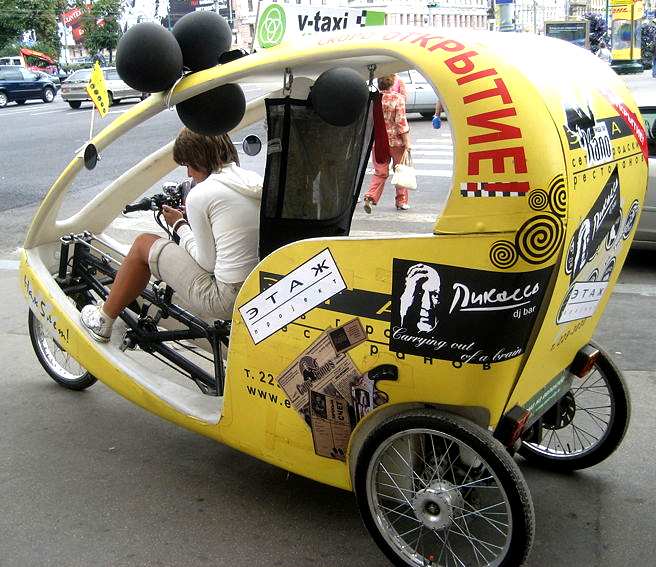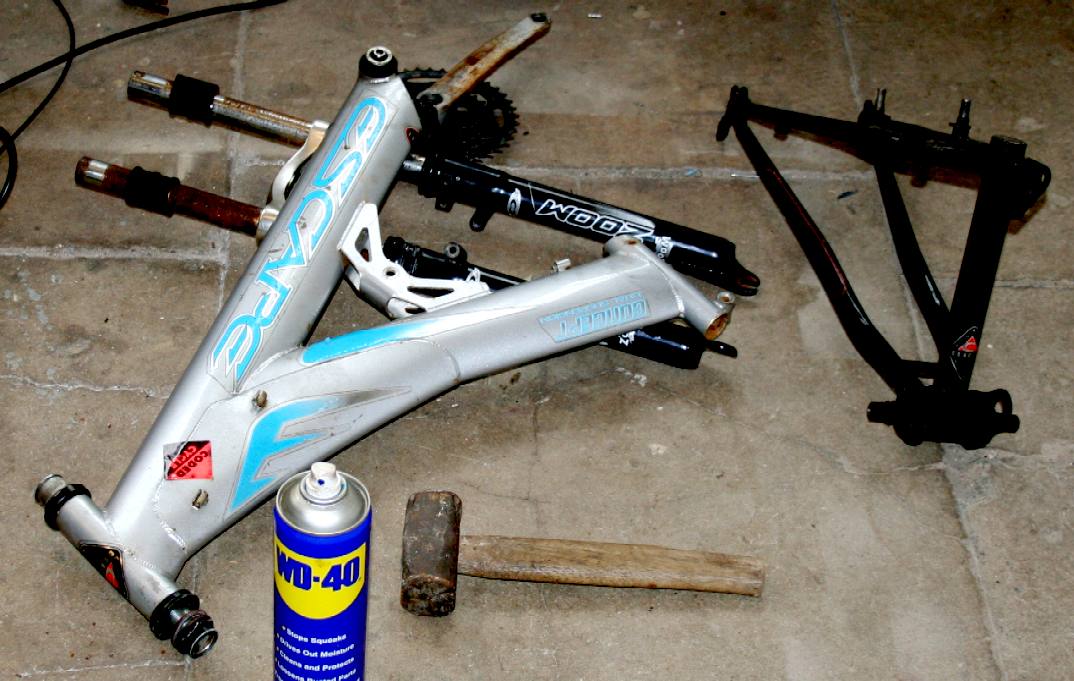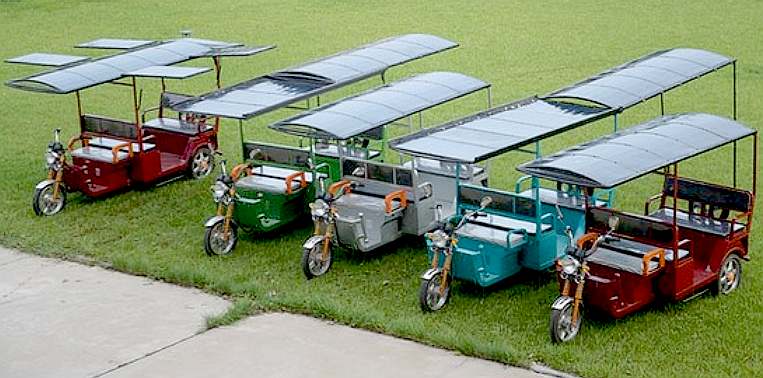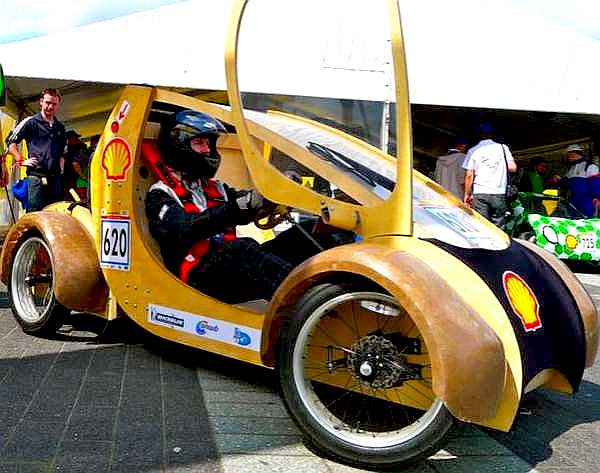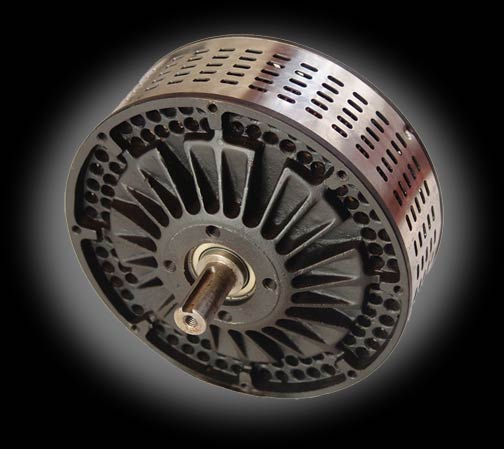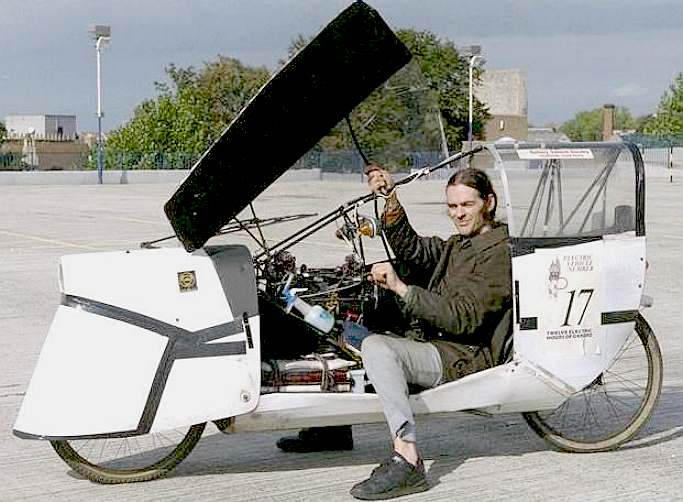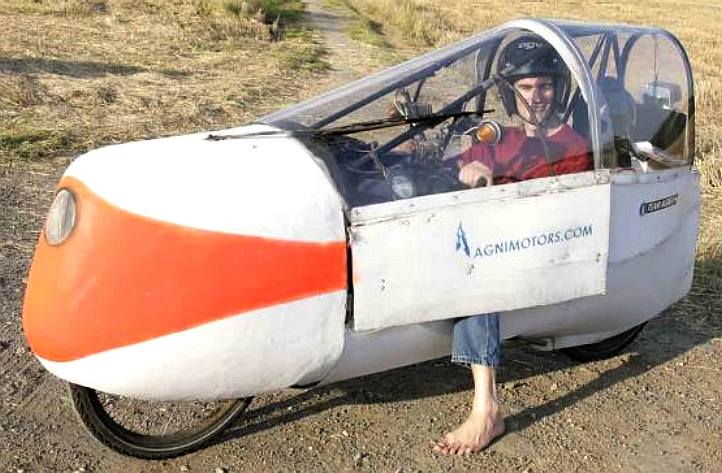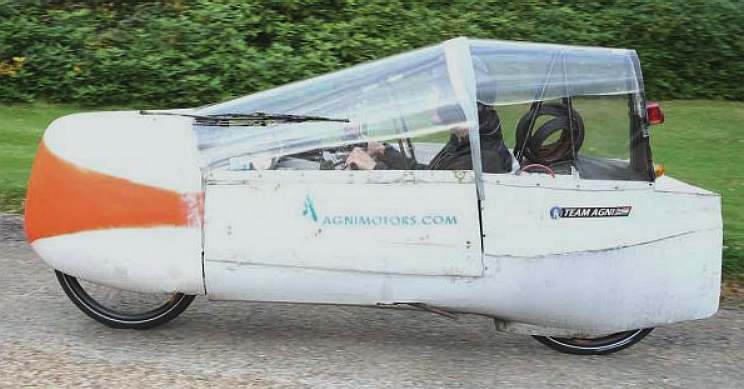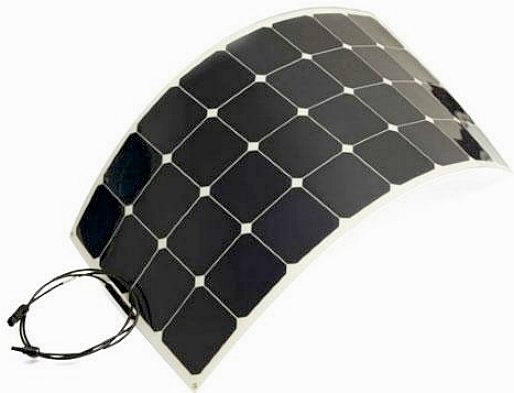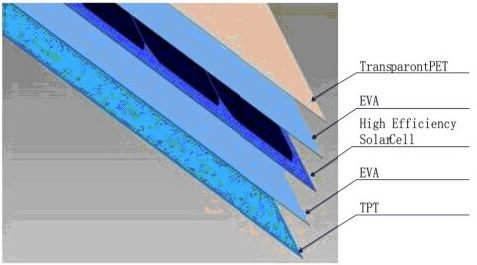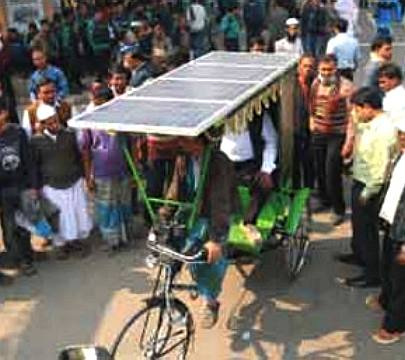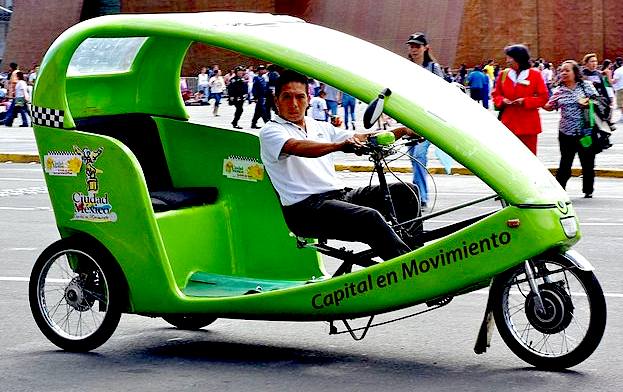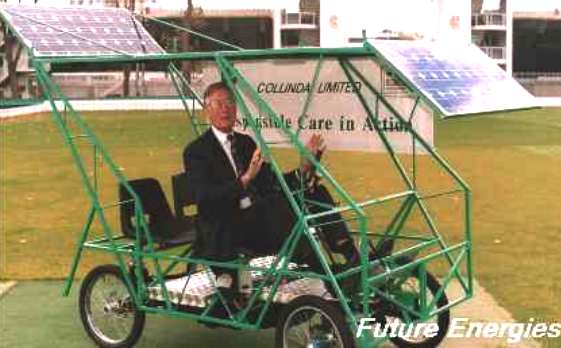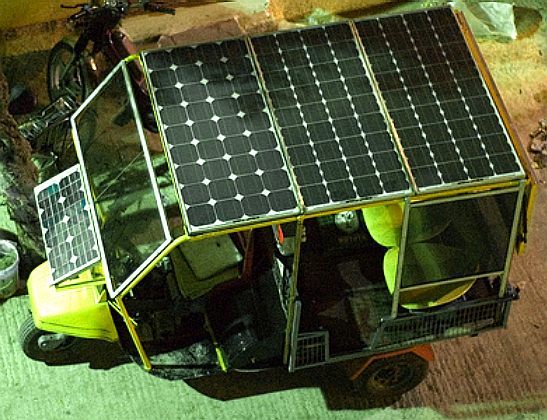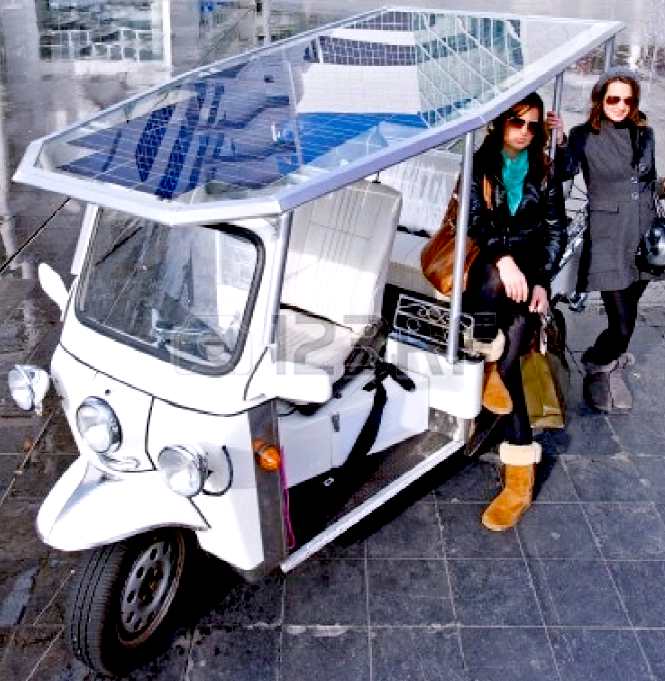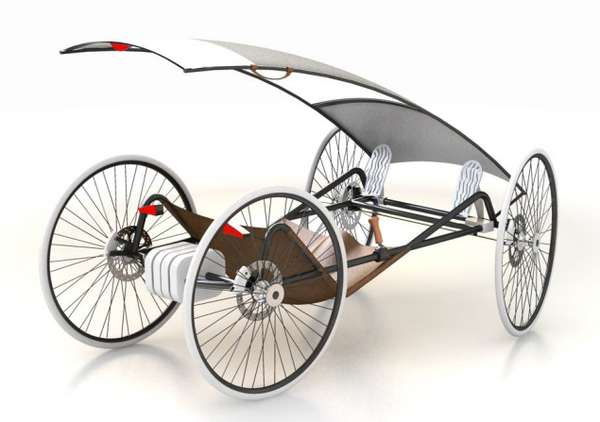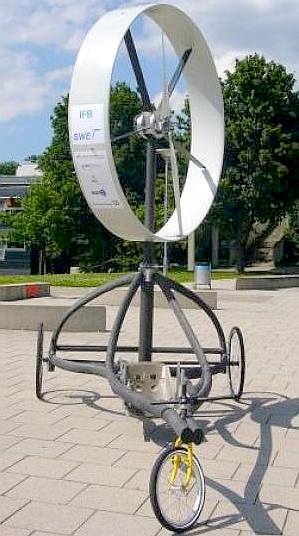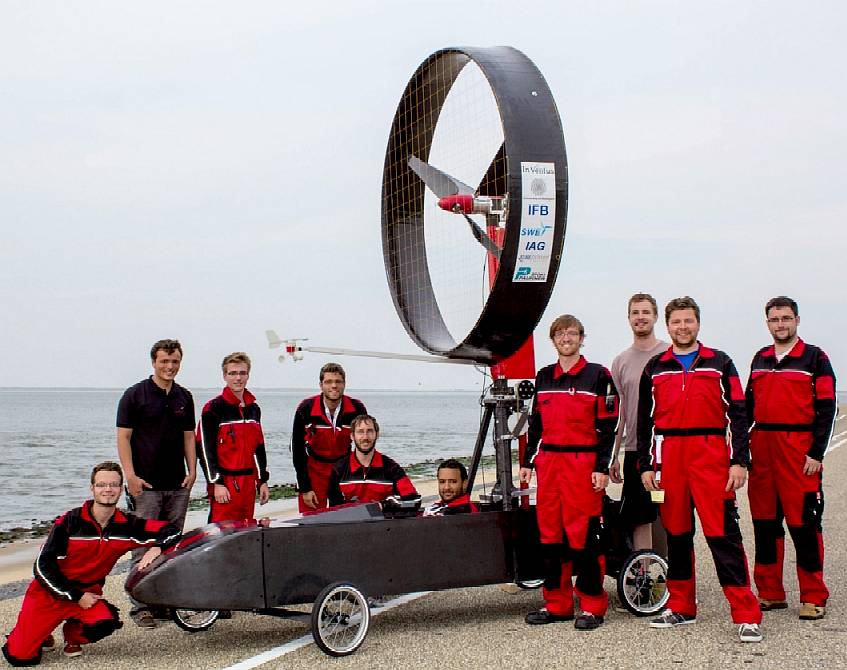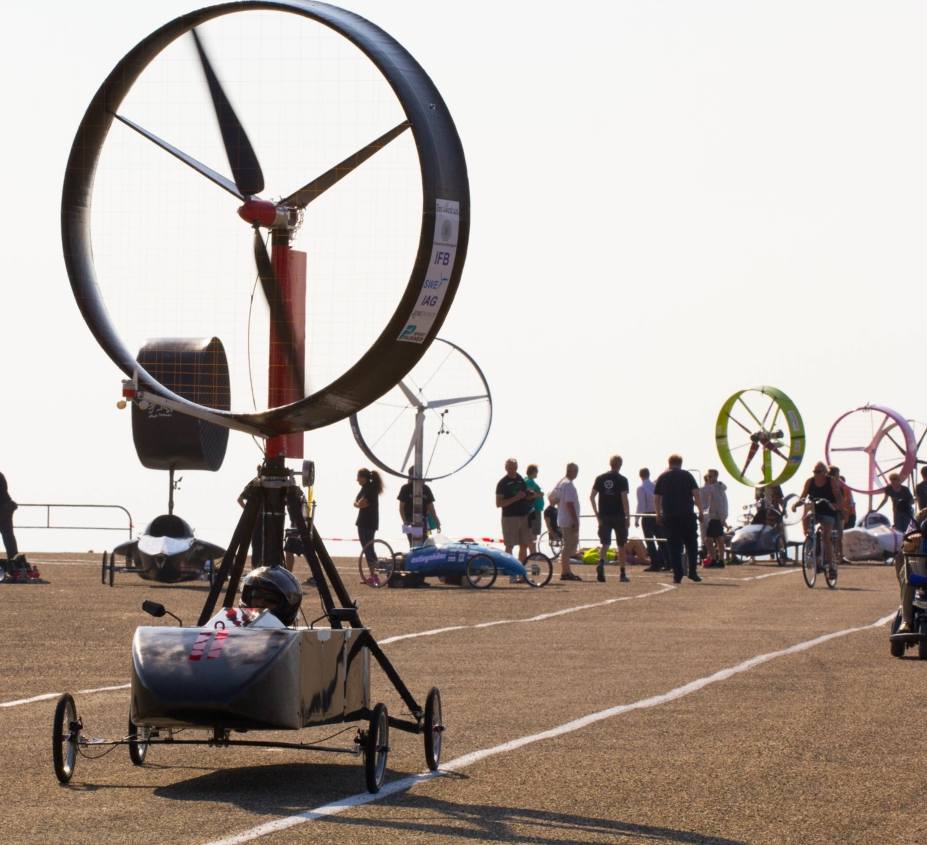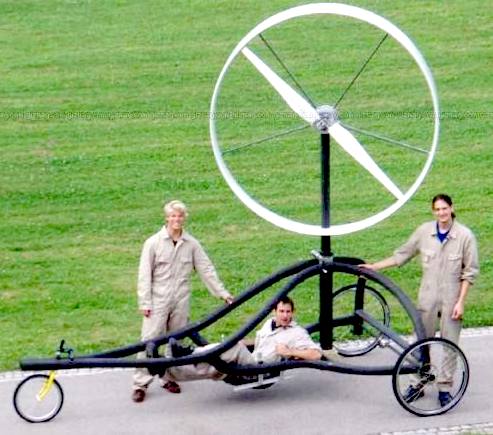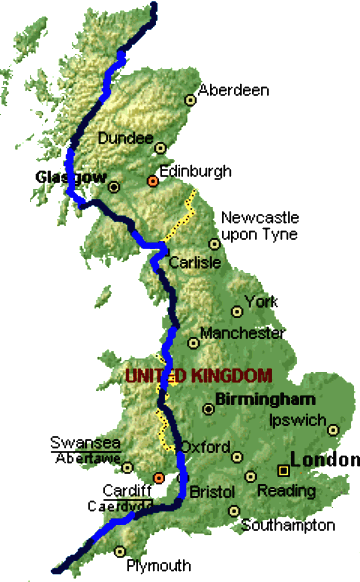|
SOLAR POWERED RICKSHAWS
|
|
|
EcoKar design studies: Four seat family rickshaw above - two seat sport model below. Both vehicles are solar powered and based on the same cycle suspension and mechanicals - and Agni (Lynch) motor. Note sizeable roof for solar panels = 2 sq meters easily.
The next stage of development is to simplify the chassis by not using cycle suspension, replacing instead with a simple wishbone design front and rear. We will then look at adding wind power to complement the solar panels. The aim is for a fashionable product that anyone would be proud to use every day - with a speed range of 40-60 mph - from 2m2 of panels.
This is a sportier version of the above. Lowering the roofline reduces wind resistance. There is scope to increase the 2 square meters of PV panels to 3 meters or more. The calculation for energy collected in the UK is 3 x 20w x 10 = 600 watt/hours a day - or .8 of a horsepower for one hour - or 48 minutes at one horsepower = 48 miles of travel free; enough to do your shopping run, or a trip to the office and back. Please note: this estimate is for sunny, summer days.
Now imagine that we add a fully charged battery from off-peak home charging, and we are looking at a 100 mile range easily. Add charging from solar rickshaw parks - and the range increase more. Finally, we have battery exchange in the form of detachable cartridges.
The energy collected figures rise considerably for India and Africa, where 220 minutes average insolation increases to 340 minutes. Hence the 600 w/hrs increases to 920 w/hrs - for 74 miles of free travel per day. These are the countries that have most to gain by developing a Circular Economy based on sustainable energy harvested from nature. We could take this chassis design further ........ for a really sizzling ride.
DESIGN STUDY
Bluebird Marine Systems are part funding the research and building (design study) of a lightweight solar powered rickshaw in association with Max Energy Ltd.
The project is codenamed: 'EcoKar.' The objective is to come up with a design which is pleasing to the eye and practical for the operator. Thus, might be attractive against the millions of fossil fuelled and pedal powered rickshaws that operate throughout Asia.
Demand is anticipated to be 10,000 units per annum by 2020. Each auto rickshaw replacement has the potential to save 10 tons of carbon dioxide emissions every year. We are interested in working collaboratively with academic institutions and companies that produce or might be interested in producing the eventual design, or supplying parts, etc.
The EcoKar solar powered Rickshaw also solves a number of issues relating to battery charging and replacement. Using the latest lithium polymer batteries reduces the mass of a battery. By incorporating the batteries as a cartridge that is quickly detachable, it is possible to develop a network of refueling points in cities such as Delhi, an ideal location to trial such innovation.
LEAD ACID (AGM) MOTORCYCLE BATTERY - By way of comparison, take a look at the YTX9-BS Powerline lead-acid 12 volt battery. They measure: Length 150 mm x Width 86 mm x Height 107 mm and have a capacity of 9 Ah with a CCA of 180 amps. Absorbent Glass Mat, or AGM technology became popular in the early 1980s as a sealed lead acid battery for military aircraft, vehicles and UPS to reduce weight and improve reliability. The acid is absorbed by a very fine fiberglass mat, making the battery spill-proof. This enables shipment without hazardous material restrictions. The plates can be made flat to resemble a standard flooded lead acid pack in a rectangular case; they can also be wound into a cylindrical cell. NASCAR and other auto racing leagues choose AGM products because they are vibration resistant. AGM is the preferred battery for upscale motorcycles. Being sealed, AGM reduces acid spilling in an accident, lowers the weight for the same performance and allows installation at odd angles.
AGM batteries have a very low internal resistance, and can deliver high currents on demand. They offer a relatively long service life, even when deep-cycled. AGM batteries are maintenance free and are lighter than the flooded lead acid type. They stand up well to low temperatures and have a low self-discharge rate. Another advantage is a charge time that is up to five times faster than the flooded version, and the ability to deep cycle. The AGM design offers a depth-of-discharge of 80 percent; whereas flooded designs are rated at 50 percent DoD to attain the same cycle life. The negatives are slightly lower specific energy and higher manufacturing costs. AGM batteries have a sweet spot in midsize packs from 30 to 100Ah. Batteries similar to these units will be suitable for rickshaw battery cartridges.
LITHIUM ION MOTORCYCLE BATTERY - Again and to compare, consider these Shido and JMT 12 volt units. They measure: Length 114mm x Width 71mm x Height 106mm and use the latest LiFePO4 technology. This battery is a direct replacement for the YTX5L-BS and YTX-4L motorcycle batteries. Two of these batteries weigh just 0.8 kilograms, or 1.76 pounds. That is considerably lighter than the Powerline setup, with a cost around four times the lead-acids. These units do not have much in the way of active lithium, but are more a large plastic container designed to mimic the original motorcycle battery - meaning that the quoted weight of 0.4kg is confusing to those estimating performance from mass.
A typical lithium-ion battery can store 150 watt-hours of electricity in 1 kilogram of battery. A NiMH (nickel-metal hydride) battery pack can store perhaps 100 watt-hours per kilogram (although 60 to 70 watt-hours might be more typical). A lead-acid battery can store only 25 watt-hours per kilogram. Using lead-acid technology, it takes 6 kilograms to store the same amount of energy that a 1 kilogram lithium-ion battery can handle. [These are averages]
Thus, if according to the packaging, the Shido unit above is rated @ 19Wh, that equates to a 1.58 amp/hours in lead-acid terminology. This is though more like 5 or 6Ah in reality because lead-acid batteries can only use 30% of their capacity due to the specific characteristics, while in lithium-ion batteries almost 100% of the capacity can be used. JMT use lithium-ion batteries as a cathode material of iron phosphate (LiFePO4) and lithium-polymer as the method of manufacture. A uniform charge of all cells is also ensured by a built-in ("balancing") processor.
RICKSHAW ENERGY STORAGE TECHNOLOGY
One obvious means of kickstarting development is to use the lowest cost technology. That would mean not using lithium batteries, but lead acid of the AGM type (see above). It is impractical to repair lead acid, or any other kind of battery, save that the construction of lithium batteries would allow for replacement of a faulty cell.
What puts people off the lithium polymer type of battery is the need to closely regulate charging of individual cells, where lead acid batteries are more forgiving. Hence, the cartridge system comes into its own, where any battery technology may be the storage medium, even allowing for change to fuel cells when the product is in full swing as a production unit.
The significant vehicle mass reduction possible (hence range increase) with lithium batteries, plus the fact that charge for charge, lithium cells are potentially more economical, cannot be ignored for when a market matures, such that local repair persons will not be challenged by newer technology.
RICKSHAW BATTERY CARTRIDGES
The key to development of a sustainable transport network is the cartridge element of the rickshaw. A key component of the cartridge system is quick exchanges.
Speedy battery cartridge exchanges will allow towns and cities to operate fleets of rickshaws that would then have a virtually unlimited range. How?
We advocate solar car (rickshaw) parks and solar home rickshaw ports. The solar vehicle parks charge vehicles that are parked and hooked up, and spare cartridges that may be exchanged - if, for example, a driver comes in but has no time to wait to hook up (plug in).
Solar rickshaws are still independent of the solar ports/parks, but will benefit enormously from the infrastructure support as and when cities and towns deem it economical to provide.
In effect, this is a mini version of the EuroStation that is proposed for EVs.
RICKSHAW VEHICLE DESIGN
The three design examples at the head of this page are just for starters. There is scope to save weight, improve aerodynamics - and increase solar panel area. Then there is the drive train to optimize, maybe even with wheel-motors. This will mean a departure from traditional designs (unfortunately) in a conservative market that is unlikely to want to evolve. Unless that is, governments look at their carbon footprint against other countries, and take action to stave off climate change. We'd suggest a compromise, where innovative design is preferred to exotic materials.
POLLUTION PROBLEM & SOLUTION
In major cities of India there are petrol and diesel powered three-wheelers called auto-rickshaws. They are some of the most polluting vehicles on Indian roads. They usually run on 2 stroke engines which are inherently more polluting than the regular 4 stroke engine. Data collected reveals that in traffic conditions prevalent in most inner city areas, these auto-rickshaws run only at 15-20 km/hr speed thereby producing even more pollution since they are designed to run efficiently at 40-45 km/hr. The pollution is further compounded by the fact that they continuously have to run in stop/start mode.
The data also shows that on an average these auto-rickshaws travel about 50-60 km. during a day. Based upon this data it was felt that an electric rickshaw designed to run 60-80 km per charge at speeds of between 25-40 km/hr would be an excellent substitute for these IC powered auto-rickshaws. In a fair weather country like India, a silent and non polluting electric rickshaw with the above attributes could be a boon. China is also a booming transport region that could stem the imports of petroleum by adopting light-weight electric sports vehicles that are at least solar assisted.
Some very attractive rickshaws here, some 3 and some 4 wheeled, but all innovative designs and a sign of things to come.
RICKSHAWS HISTORY
The cycle rickshaw is a small-scale local means of transport; it is also known by a variety of other names such as bike taxi, velotaxi, pedicab, bikecab, cyclo, beca, becak, trisikad, or trishaw.
SALVAGE - Rather than experiment with new parts, we are using using recycled parts from many redundant machines and bicycles. Some of the bearings, steel and sprockets came from push-bikes. When you have a rig that works well, of course, use new parts that may have a higher specification. The steel and alloy parts of bicycles are relatively high quality - because a bike has to be light and functional - just like a robot. The Wright Brothers were cycle makers. They used their bicycle making skills to create an aircraft. When disassembling a push bike for parts, be sure to use the correct tools. For taper-fit cranks you will need a threaded extractor tool and for chains a link-extractor. Modern bike chains do not have the split links that were common in years gone by.
ELECTRIC ASSIST PEDICABS
Across Asia, the auto-rickshaw or as it’s commonly known in Thailand, the “tuk
tuk” is a staple in everyday transportation. With the help of Australian company Star 8, the humble tuk tuk is about to get a solar make over.
Competitor in the Shell Eco Marathon events, supported by National Geographic. This is a very simple design made of materials such as cardboard. The three-wheeler could carry solar cells to become an efficient rickshaw, or personal city transport.
LEGISLATION
This is a project that was started in 2005 for a school, but was shelved. Subsequently no funding was available as a serious research project. But, Bluebird Marine Systems have now acquired the components in the hope that Horizon or other more local funding initiatives might be able to help support a scientific research project. Two ordinary small mountain bikes are the donor vehicles (made in India) for the working mechanicals to construct a frame to carry two people at speeds of around 50mph using solar roof panels and batteries to provide free transport in the UK. This might be an ideal postal delivery vehicle, or for any other service involving light deliveries such as medicines and newspapers.
Agni-Lynch Motors - Just one of these little marvels will propel a rickshaw at practical speeds. Check out Cedric's 60 mph road legal bike below. It may not be the prettiest machine around, but it does the job. It can travel from London to Birmingham on one small battery. It is now fitted with lithium cells to increase range and speed - and why no solar panels Cedric? Mind you, there's not a lot of roof space. The bike could do with a makeover - then might be a saleable vehicle. We have heard that Cedric is not a commercial animal. See http://www.agnimotors.com for more details.
TECH STUFF - WILL SOLAR POWER WORK?
At present, rickshaws are being replaced by internal combustion machines of various kinds, and that trend is likely to reverse as a result of higher oil prices. But is a solar powered rickshaw viable?
As a rule of thumb, the sun supplies around one kilowatt of energy per square metre, which just happens to be the roof area of a typical rickshaw. Unfortunately, another rather more depressing rule of thumb suggests that commercial panel efficiency is somewhere in the region of 10%, even though 21% is achievable. But this reduces peak power to 100 watts instead of 210 watts. In practice, Unisolar flexible panels do even worse with British solar radiation, achieving a peak output equivalent to 65 watts per square metre, or 390watt/hours (or Wh) per day.
The roof of the
Maximus rickshaw (used as an example) measures approximately 100cm by 110cm, giving a practical collection area of about 1.1 square metres.
Thus, provided the rickshaw was always in the open – something hard to arrange in a cityscape, for example – we could reasonably expect to see peak power of 72 watts, and daily output of 430Wh.
Another problem is cloud cover – even in June, the average panel output
would be cut by almost 50%, to 36.6watt/hours per day. Taking these factors into account, it’s unlikely that
the example rickshaw would generate more than 200Wh per day in fine
weather and virtually nothing on an overcast winters day.
1. More panel area. 2. Sun tracking. 3. Better aerodynamics 4. Battery exchange. 5. Car port charging
FLEXIBLE PANELS - Solar panels are now available that are flexible, light and more than 21% efficient. You need to shop around for the best deals.
But
more in these game changers later. To continue: with the less powerful Heinzmann motor, the equations become a little more favourable – somewhere in the region of ten hours charging per motor/hour.
We should also consider that the Maxims is far from the epitome of
rickshaw design in terms of mass.
There are also a number of ‘exhibition,’ or concept solar machines around, but these are a long way from earning a living day-to-day. The rate of future developments will most likely depend on the price and availability of oil, and of course the political will, in making funding available to SMEs. Banks will not lend against such research.
BANGLADESH CHRONICLE - BEEVA TECH 2012
Beeva Tech Ltd, one of the country’s electric tricycle makers,
launched a newly designed solar-charged electric rickshaw for the local
market in 2012.
The four wheel rickshaw being demonstrated in this picture by Michael Meacher, is a brave attempt to get as many solar panels on the vehicle as possible. That is the main challenge. How do you increase PV area and still remain attractive. No way is the Colinda sponsored vehicle attractive, though the base mechanics are excellent, to include the superb tilting mechanism that allows the solar panels to track the sun.
The Inventus above is based on rickshaw mechanicals. Could wind power add to solar power for land vehicles? It is certainly worth considering. We have not seen any published research on this project. SWE - The Endowed Chair of Wind Energy (SWE) is affiliated to the Institute of Aircraft design at the faculty of aerospace engineering at the University of Stuttgart. The work of the wind energy pioneer Prof. Dr.-Ing. Ulrich Hütter (1910 - 1989) is continued within research and teaching programs. The expansion and usage of wind energy and other renewable energy sources is actively supported.
LINKS
Rickshaws-that-run-on-solar-power Solar-powered-auto-rickshaws-solartuk India-launches-first-electronic-solar-rickshaws-for-postmen http://www.bangladeshchronicle.net/index.php/2012/01/rickshaws-that-run-on-solar-power/ http://www.atob.org.uk/technical/solar-rickshaw/ http://energis.com.au/solar-powered-auto-rickshaws-solartuk-for/ http://electronicsb2b.com/industry-buzz/india-launches-first-electronic-solar-rickshaws-for-postmen/ http://en.wikipedia.org/wiki/Cycle_rickshaw
|
|
|
This
website is Copyright © 2014 Bluebird Marine Systems Limited.
The names Bluebird™,
EuroStation™, and the blue bird in flight
|
|
